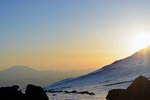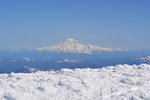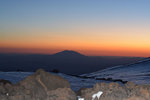


Mount Adams, in Native American lore, once competed with Mount Hood for the love of the beautiful Saint Helens. In another legend, Saint Helens and Rainier had their own fight over Pahto, as the area tribes called Adams.
It’s easy to see how these stories came to be. From the high slopes of one volcano, the others begin to appear like neighbors, visible in their full prominence, the scores of forest miles in between little more than an undulating lawn. The volcanoes exist on their own scale, and as such, they must have their own tales.
“The Forgotten Giant of Washington,” Mount Adams doesn’t have the status to match its stature as the second-highest peak in the state. The iconic Rainier towers to the north, visible from Seattle. To the east, Saint Helens’ explosive tendencies give it a mystique beyond its more diminutive height.
Amid Southwest Washington’s triangle of volcanoes, Adams is the only one that doesn’t have a footprint here in Lewis County. It’s positioned just north of of Oregon, more visible from across the Columbia River than it is from much of the county.
Start climbing its slopes, though, and Hood and Saint Helens start to appear like peers, giants of the same kind, snowy masses indifferent to their current status in the regional consciousness. In the same way, Lewis County ceases to become a map boundary an indeterminate distance away — it’s just over that next mountain, after all.
I set out for Adams last weekend, accompanied by my friend Piotr Walaszek. We met on the Pacific Crest Trail last year, hiking nearly 700 miles together before he had to leave the trail to rehab his injured back. Piotr lives in Seattle, and he’d been a convincing voice in urging me to move to the Pacific Northwest after I finished the PCT. He brought along his friend Piotr Kulaga, a fellow Pole who will henceforth be referred to by his nickname Piotrek, in order to distinguish between the Piotrs.
We began our climb Saturday afternoon, starting about three miles below the trailhead where snow had made the road impassable. Soon, our feet were plunging hip-deep in the slushy snow, and we strapped on snowshoes to keep from sinking in. Before long, Mount Hood came into view in the south, quickly joined by Saint Helens as the switchback road meandered up.
Joining the trail, we trudged up through the slush, quickly leaving behind the whine of snowmobiles as we crossed into federal wilderness. We took a break on some rocks, ate snacks and reapplied sunscreen. Each slope was followed by another, a series of climbs that seemed to bring the high reaches of the mountain no closer.
We passed a butte to the right, a jumble of volcanic rock that had shrugged off the white blanket of the surrounding slope. Our path brought us up from the south side of the mountain, a route that doesn’t require much technical mountaineering, but still entails nearly 7,000 feet of climbing. Temperatures climbed into the 70s, and the glare of the snow and strain of climbing with full packs sent sweat streaming down our faces.
After a some more ascending slopes, we came to the Lunch Counter, an area of protruding boulders and space less steep than the surrounding area. We made camp here, using a snow shovel to flatten out space for our tents. Firing up our camp stoves, we melted pot after pot of snow, giving us ample water for the next day.
As the sun dipped behind the south slope of Adams, Saint Helens appeared in silhouette, backdropped by the pink and orange hues of sky. A hazy Hood added its contours to the southern sunset light. The temperature dropped quickly, and a persistent wind began thrashing our tents. After a quick pull of whiskey, we made a beeline for the warmth of our sleeping bags, knowing we’d have to emerge at dawn to begin our summit push.
I spent most of the night listening to my tent flap in the wind, the noise and an altitude-induced headache keeping me from sleep. I did take a moment to appreciate the clear field of stars when I briefly exited the tent to empty my bladder.
Bleary-eyed, we got up with the sun, wrapped in layers to handle temperatures that were now in the teens or twenties. I kneaded flexibility back into my frozen shoelaces, pulled on my trail runners and strapped on crampons. Swapping my hiking poles for my ice axe, I left camp, glad to be climbing on frozen snow instead of the slush from the day before.
“Man, I’m tired,” I told Piotr.
“I feel great,” he replied cheerily.
I grumbled and headed upward. Above us towered an impassive, nearly featureless slope, a face of white barely broken by rocks or ridges. There were no obstacles to encounter, but nothing to break the 2,000 or so feet of climbing. If the monolith was daunting, it was made even more so by the fact that its far-away peak was not the end of our journey. This was Pikers Peak, a false summit still hundreds of feet below the real heights of Adams. We wouldn’t even see the true summit until we got over this one.
The climb was a slow one, step-over-step in slow motion. The teeth of my crampons bit into the hard surface, and I lifted one heavy leg at a time. A howling wind blew straight down on us. Piotr and Piotrek followed behind, and we stopped frequently to catch our breath in the paltry air. A paper-thin sheen of ice covered the snow, and it shattered into fragile fractals with each crunchy step.
After a couple hours of climbing, we came over Pikers Peak and saw our destination looming above. We dipped into a small bowl and began climbing again. By now, we couldn’t go long at all without stopping for breath, but the summit slowly started appearing closer.
With one last push, I gained the peak. Coming over the ridge, Rainier made its grand appearance, dominating the northern horizon and joining Hood and Saint Helens as the giants overseeing the region. Past Hood, Mount Jefferson appeared faintly more than 100 miles to the south, a distant relative.
As Piotr and Piotrek made their way up, I quickly threw on the down coat I’d shed during the strenuous climb. The wind at the summit was merciless, and the temperature still well below freezing. My buddies finished their ascent, and we admired the view together. We high-fived and snapped a few photos before the conditions drove us back down.
Once we made our way back to Pikers Peak, that unbroken face of snow offered us a shortcut down. We sat down and glissaded, using our butts as sleds and gravity as our accelerator. With the surface still nearly ice-hard, we came down roller-coaster fast, earning more than a few bumps from uneven spots in the snow. My ankle trickled blood where it had sliced on some unforgiving ice. Within minutes, we had given back all the elevation it had taken so many hours to climb.
Exhilarated, banged up and soggy, we walked over to camp to scarf down a big lunch. I squirted a concentrated drink mix into the snow to make a refreshing, grape-flavored snow cone. Once we packed up our tents and gear, we set out for the car, once again relying on snowshoes to handle the conditions brought on by the steady overhead sun.
By Sunday afternoon, the route we’d taken up was softer than ever, leaving us sinking in even with snowshoes. At one point, we lost our path and had to clamber over some rocks to get back on track. More than once, our footing gave out, leaving us falling and sinking into the snow.
After a long hike down, we finally reached the car, sunburnt, spent and sore. But we weren’t out of the woods yet. My car misfired, and 10 miles up a rutted, single-lane dirt forest road, we couldn’t find a towing company that would bring it off the mountain. Eventually, we hitchhiked into Trout Lake and found a local who took us back up in his pickup truck. He was able to coax enough power out of my car to putter down the mountain, and we returned to Trout Lake to await a tow.
By Sunday night, we’d gotten my car to Hood River, where I’d spend the night waiting for the mechanic shop to open. Piotr and Piotrek had some friends pick them up to get back to Seattle, and we said goodbye after a satisfying adventure, albeit one that was ending on a sour note.
Monday afternoon, I was back on the road with a working car and a lighter wallet, getting back to Centralia that evening. If my coverage of Lewis County’s Board of Commissioners meeting and Chehalis city council was delayed, local officials were more than happy to follow up with what I’d missed during my misadventure.
After all that, I’m sure it won’t be long before I again put myself — and my beat-up Outback — to the whims of a mountain. After all, I still haven’t seen Adams from the flanks of Saint Helens. I’m still getting to know the neighborhood.